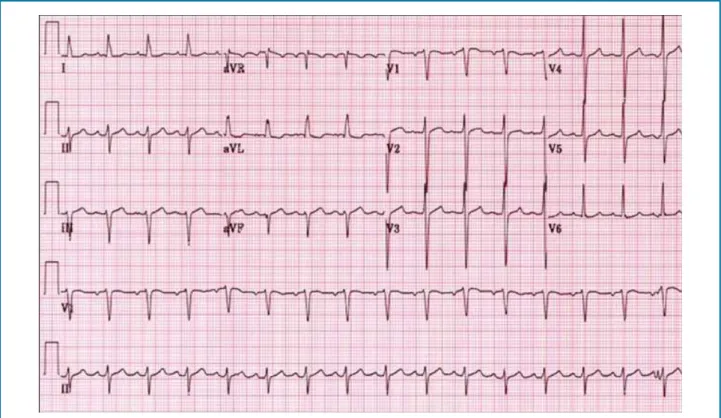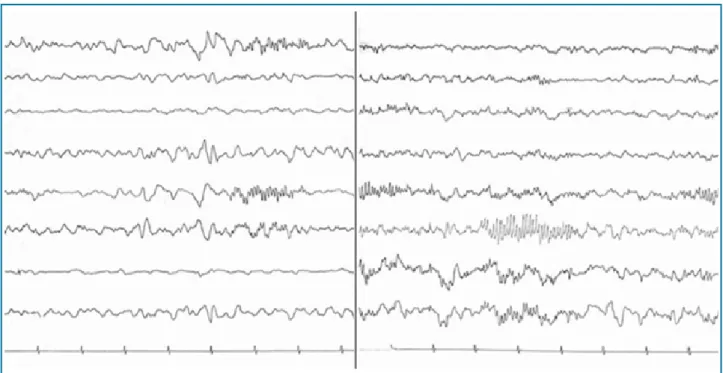DOI: 10.5935/2359-4802.20170016
95
International Journal of Cardiovascular Sciences. 2017;30(1):95-97
CASE REPORT
Mailing Address: Renato Niemeyer de Freitas Ribeiro
Estrada do Capenha, 1431, apartamento 202, bl 01. Postal Code 22743-041, Jacarepaguá, Rio de Janeiro, RJ – Brazil E-mail: renato.niemeyer@hotmail.com
Rare Case of Hypertensive Crisis Secondary to Diencephalic Epilepsy
Renato Niemeyer de Freitas Ribeiro;1 Wolney de Andrade Martins;2 Bruno Niemeyer de Freitas Ribeiro3
Hospital de Clínicas de Jacarepaguá;1 Curso de Especialização em Cardiologia da Faculdade de Medicina da Universidade Federal Fluminense (UFF);2
Instituto Estadual do Cérebro Paulo Niemeyer,3 Rio de Janeiro, RJ – Brazil
Manuscript received September 02, 2016; revised manuscript November 21, 2016; accepted January 23, 2017. Hypertension / complications; Hypertensive
E n c e p h a l o p a t h y / c o m p l i c a t i o n s ; E p i l e p s y ; Hypothalamic Diseases.
Keywords
Introduction
Hypertensive crisis (HC) is a clinical situation characterized by the quick, inappropriate, intense and symptomatic elevation of blood pressure, with or without risk of target-organ deterioration.1 HC has shown a decrease
in incidence, most likely due to the advancement of outpatient antihypertensive therapy,2 but it still represents
a challenge in emergency clinical practice. In over 80% of cases, patients already have a previous diagnosis of arterial hypertension (AH).3 However, undiagnosed AH
or secondary causes may be the etiology of HC.
Case report
Female patient, 49 years old, from Angola, went to the emergency unit of a secondary hospital. She presented with lethargy and mental confusion, profuse cold sweating, elevated blood pressure levels (238 x 146 mmHg) and tachycardia (102 bpm). Cardiac and pulmonary auscultation were normal and without focal neurological signs. It was characterized as hypertensive emergency. She reported similar episodes during adolescence, with profuse cold sweating, followed by erection of hairs, but with spontaneous resolution and short duration. The patient denied the use of illicit drugs, contraceptives and hormone replacement therapy.
Lab exams such as hemogram and serum blood glucose, sodium, potassium, CK-MB, and troponin 1 came back normal. ECG (Figure 1) showed sinus tachycardia. Head CT was normal. Diagnostic investigation was complemented with a transthoracic echocardiogram,
echo-doppler of renal arteries, and aortography, as well as a lab research for pheochromocytoma, Cushing’s syndrome, acromegaly, hyperaldosteronism and dosage of thyroid hormones, with all exams within the parameters of normality.
The patient was started on treatment for hypertensive emergency, and the patient was transferred to the intensive care unit (ICU) on venous nitrate, reaching a value of 162 x 104 mmHg in the fourth hour after admission.
During her stay in the infirmary, antihypertensives were suspended since the patient showed intolerance to the medications, with hypotension maintained with minimal doses (enalapril maleate 5 mg, twice a day).
During outpatient follow-up, the patient remained asymptomatic, with physical examinations persistently normal even without the use of antihypertensives.
Approximately three months after the first episode, the patient manifested the same symptoms, with new admission to the ICU, where she displayed a similar clinical behavior; that is, notably elevated levels of blood pressure responsive only to intravenous nitrate, with posterior hypotension and intolerance to low doses of antihypertensives.
Based on the clinical history of the first admission, an electroencephalogram (EEG) was performed (Figure 2) during this second hypertensive crisis, showing positive spicules (14 and 16 per second); and so the diagnosis was of diencephalic epilepsy. Plasma catecholamines were measured at the time of the crisis and 24 hours after that. The first one was elevated, and the second was normal, which corroborated the diagnosis.4 Treatment with carbamazepine
was initiated,4 which yielded good therapeutic response.
96
Figure 1 – ECG: tachycardic sinus rhythm, PR 0.16 seconds, heart rate 150 bpm; Superior divisional block.
Ribeiro et al. Hypertensive crisis in diencephalic epilepsy Int J Cardiovasc Sci. 2017;30(1):95-97
Case Report
Discussion
Even though most cases of HC occur in previously hypertensive patients, especially those on irregular treatment, and the main etiology is idiopatic,2 secondary
causes must always be on the assisting doctor’s radar. With the patient in question, the crises were due to a diencephalic epilepsy. It is important to highlight the importance of epilepsy in developing countries of Africa, Latin America, and Asia, where the prevalence rate is 4 to 5 times higher than in industrialized countries.5
The diencephalon is the central nervous system structure formed by the thalamus, hypothalamus, epithalamus and subthalamus. In the context of this clinical case, it is worth mentioning the role of the thalamus in the emotional behavior and cortical activation, and of the hypothalamus in the regulation of the autonomous nervous system and body temperature. Diencephalic epilepsy is a clinical entity, in which discharges from the hypothalamus or from the anterior portion of the thalamus may cause tremors, erection of hairs, sensation of fear, sweating, plenitude, nausea, and dyspnea, as well as tachycardia
and blood pressure elevation, among other signs of sympathetic dysfunction. EEG, in addition to the clinical evaluation and response to anticonvulsants, is an important diagnostic instrument, because it demonstrates positive spicules (14 and 16 seconds). Anxiety disorders are included in its differential diagnosis. It is worth mentioning that in a HC derived from a status epilepticus and not related to hypertensive encephalopathy, the patient may present with hypotension after the first acute hypertensive event,5 just like the patient in question. It is also
important to mention that most cases of diencephalic epilepsy associated to severe hypertension are reported in comatose patients, victims of serious traumatic brain injury;6,7 however, the patient in question did
not present a history of brain injury. Treatment with carbamazepine yields good responses,4 with
gabapentin as a second option.7
97
Figure 2 – EEG: positive spicules (14 and 16 per second).
1. Silva MA, Rivera IR, Santos AC, Barbosa CF, Oliveira Filho CA. Hypertensive crisis, pseudo-hypertensive crisis and symptomatic increase in blood pressure. Rev Bras Cardiol. 2013;26(5):329-36.
2. Victor RG, Kaplan NM. Hipertensão sistêmica: mecanismos e diagnóstico. In: Braunwald E. Tratado de doenças cardiovasculares. 8ª. ed. Rio de Janeiro: Elsevier, 2010. p. 1027-70.
3. Rodriguez P, O’flaherty M, Forcada P, Grassi D, Diaz M, Ferrante D, et al. Estudio REHASE (Relevamiento de Hipertensión Arterial Severa en Servicios de Emergencia): características de la población y respuesta a una estrategia de manejo. Rev Argent Cardiol. 2006;74(2):102-8.
4. Metz AS, Halter JB, Porte D Jr, Robertson RP. Autonomic epilepsy: clonidine blockade of paroxysmal catecholamine release and flushing. Ann Intern Med. 1978;88(2):189-93.
5. Scorza FA, Arida RM, Albuquerque M, Cavalheiro EP. Epilepsias e hipertensão arterial sistêmica. J Epilepsy Clin Neurophysiol. 2006;12(2):219-24.
6. Hörtnagl H, Hammerle AF, Hackl JM, Brücke T, Rumpl E, Hörtnagl H. The activity of the sympathetic nervous system following severe head injury. Intens Care Med. 1980;6(3):169-77.
7. Baguley IJ, Heriseanu RE, Gurka JA, Nordenbo A, Cameron ID. Gabapentin in the management of dysautonomia following severe traumatic brain injury: a case series. J Neurol Neurosurg Psychiatry. 2007;78(5):539-41.
References
Ribeiro et al.Hypertensive crisis in diencephalic epilepsy
Int J Cardiovasc Sci. 2017;30(1):95-97
Case Report
Author contributions
Writing of the manuscript: Ribeiro RNF, Martins WA, Ribeiro BNF. Critical revision of the manuscript for intellectual content: Martins WA, Ribeiro BNF.
Potential Conflict of Interest
No potential conflict of interest relevant to this article was reported.
Sources of Funding
There were no external funding sources for this study.
Study Association

